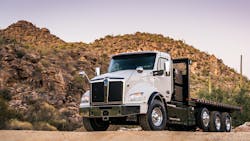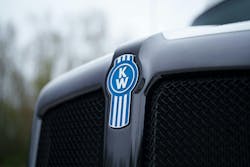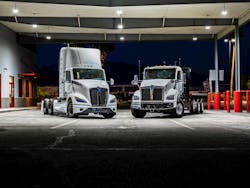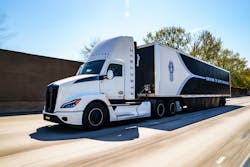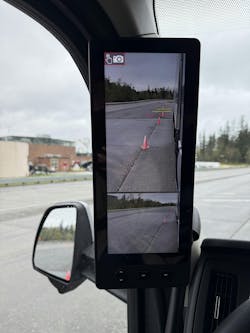Kenworth debuts vocational-focused Class 8 EV: The T880E
Key takeaways:
- A new advanced ePowertrain, designed by Paccar, will be integrated across Kenworth's heavy-duty BEV lineup, including the all-new battery-electric T880E and the next-gen T680E.
- Kenworth’s new advanced battery-electric powertrain adds increased range, is applicable across a range of applications, and advances the battery’s charging capability.
Logos can often be iconic. Just one graphic, patch, or emblem can represent an entire brand or an entire company.
Those in the trucking industry know the Kenworth logo. It rests on every grille of Kenworth trucks: the vertical red-and-white stripes and the bold K and W in white.
But recently, Kenworth did something new and modified its logo to get the word out. It added to its lineup of battery-electric trucks and gave each a modified Kenworth logo.
The modified logo, identical to the classic KW logo except for its light blue coloring, signifies Kenworth’s zero-emission lineup. While the BEVs are the only zero-emission Kenworth trucks available today, the truck manufacturer plans to bring additional zero-emission vehicles to the market in the future, Sarah Abernathy, Kenworth’s advanced powertrain marketing manager, told FleetOwner.
While Kenworth already offers an electric medium-duty truck, the Kenworth K270E/K370E, and an electric heavy-duty truck, the Kenworth T680E, Kenworth recently added a heavy-duty vocational electric vehicle to its lineup with the T880E. This truck features an electric powertrain built from the ground up, and the new battery-electric architecture will be carried over into new generations of the Kenworth T680E. FleetOwner had a chance to drive them.
All-electric Kenworth T880E
All-new T880E specs
- Features the new Paccar-designed ePowertrain system
- 365-470 hp and 1,850 lb.-ft. of torque
- Four battery configurations for customization and application
- Customizable range from 100 to 250-plus miles
- Multiple wheelbase and vehicle configurations
- CCS1 DC charging with 350 kWh peak charge rate
- Charges to 90% in about two hours
- Factory-installed options for high- and low-voltage ePTO ports
- Features 15-inch DriverConnect digital touchscreen
The new Kenworth heavy-duty BEVs feature a Paccar-designed “ePowertrain platform” that’s built from the ground up, Kenworth Chief Engineer Joe Adams said. The advanced powertrain sought to provide three main things: increase the range, be applicable to multiple applications, and decrease the time to charge.
The all-new T880E and the T680E with the enhanced powertrain offer a range of 100 to 250 miles. This is quite a step up from the T680E’s previous generation, which offered a range of up to 150 miles.
With the multiple battery configurations available through this new battery electric powertrain architecture, Kenworth was able to enhance the range of its T680E and debut the T880E with a higher range. Customers can spec these vehicles to include from two to five battery packs, or what Kenworth calls 2 String to 5 String, depending on their needs. A 2 String battery configuration delivers a range of up to 100 miles, and the 5 String battery configuration, the largest configuration available, offers up to 625 kWh of energy, delivering more than 250 miles. Further, the T880E features 365 to 470 continuous hp and up to 605 peak hp with 1,850 lb.-ft. of torque.
Because it’s capable of charging at a rate of 350 kW, the T880e can charge up to 90% in just two hours.
A zero-emission vocational machine
Next-gen T680E specs
- Features the new, Paccar-designed ePowertrain system
- 365-470 hp and 1,850 lb.-ft. of torque
- Three battery configurations for customization and application
- Up to 200-plus-mile range offered with 82,000-lb. GVWR
- Complete exterior redesign
- Upgraded digital interface
- 15-inch DriverConnect display
- CCS1 DC fast charger with a 350 kWh peak charge rate
- Charges to 90% in about two hours
- Designed for short and regional-haul, LTL, and drayage applications
- Available as day cab, tractor, or straight truck in 6x4 configuration
“Kenworth continues to spend a lot of energy investing in advanced powertrains to really grow that portfolio so that we have an application for every job,” Adams said—and it’s fitting that the brand would launch a vocational vehicle to help tout this new ePowertrain, designed to fit multiple applications.
The T880e was built as a zero-emission vocational workhorse. Its customizable design can suit several applications, thanks to the Paccar-built, central-drive eMotor.
“When we go into the vocational space, there's a lot of applications where there's specific needs on the back half of the vehicle,” Adams explained. “The midship motor gives us the capability of having all the axles, the drive line—all being standard components. Suspension components are all standard to what someone may use on a diesel vehicle."
“With a midship [eMotor] design, we connect into that with our drive line ... and the backend looks very much like what a vocational customer would want,” he continued. “A lot of consideration has gone into how we've designed the product line so that we can span this very broad application coverage that we want to intend with our battery-electric vehicles.”
Further, the T880e features the option for factory-installed ePTO ports for both high and low voltage. These can be used “to power equipment, a mechanical ePTO, or body configurations in conjunction with aftermarket body upfitters,” Kenworth stated in a release.
Kenworth’s vocational BEV is also designed to complement its ICE-powered counterpart to ease the transition from diesel-powered rigs to battery-electric ones. Like the ICE T880, Kenworth offers the T880E in both a set-back front axle configuration and a set-forward front axle configuration. The BEV also offers the multipiece hood construction as the ICE versions of the T880.
See also: How fleets can choose the right alternative powertrain
Driving Kenworth’s BEV lineup
Ahead of its launch at ACT Expo, Kenworth invited members of trucking media to drive the new T880E at its test track near Seattle, Washington. The Kenworth team also had other trucks available to drive, including a diesel-powered T880, a diesel-powered T680, and a natural gas-powered T680.
I’ve driven EVs but not fully loaded Class 8 battery-electric vehicles, and especially not in a situation where I was able to go from behind the wheel of a Class 8 BEV and immediately jump into the cab of a Class 8 ICE vehicle. This instant comparison between the ICE vehicles and their battery-electric counterparts made my test drives a challenge.
I hopped into the loaded T880E, buckled up, and took off. The immediate torque had me reaching higher speeds at a pace similar to my personal vehicle (though, as expected, the heavy weight loaded on the vocational machine did make an obvious difference).
The ride around Kenworth’s test track was smooth. I was focused on the road, able to have a conversation with my passenger, and returned safely. Upon my return, my honest thought was: “Well, that was uneventful.”
It wasn’t until I immediately hopped into a diesel-powered T680 (equipped with a Paccar MX-13 engine offering 455 hp) that I found a true appreciation for Class 8 BEVs.
I don’t have my CDL, and I only get to drive big rigs during media events with closed or private test tracks, but I quickly recalled the familiarity of a diesel-powered Class 8’s lagging start off the line after pressing the accelerator in the loaded T680. It’s the feeling behind the lagged start, the lunge forward and back as the gears shift, and the bouncing air-ride seat that’s all too familiar with big rigs—and that’s something I didn’t miss in the T880E BEV.
Compared to the T880E’s instant torque, it seemed to take forever to get the T680 up to speed around the track. While the diesel-powered T680 performed well relative to what it is—a Class 8 truck powered by an ICE engine pulling nearly 80,000 lb.—compared to the Class 8 BEV, there was a clear winner.
When I got into the battery-electric T680E, the comparison was even more stark. It hauled a heavier load with such ease that I had to keep telling myself, “You’re driving an 80,000-lb. machine—be careful,” scared I would get too lax behind the wheel.
Driver-focused technology
Not only did the T680E pull the weight easily, but it was also outfitted with Kenworth’s latest and greatest technology perks, which Kenworth calls its “driver-focused technology.”
The T680E featured digital vision mirrors, which are large, side mirror-shaped monitors within the cab that display camera views that are the equivalent of traditional side mirrors. I found that I preferred them to traditional side mirrors, as their positioning inside the cab made it easier to glance back and forth between them and the road.
The T680E also featured a 15-inch digital information cluster and a 15-inch infotainment screen. For Kenworth BEVs, the infotainment screen features a page that displays battery performance metrics, available auxiliary power, and more. It’s also within the infotainment screen that drivers can manage their charging; they can schedule charging for later and set a maximum charge.
Kenworth also made a way for drivers to set a “Planned Departure” time. When that time is set, the truck will preheat the battery and get it ready for use. This helps maintain battery performance over the life of the vehicle.
See also: Test your knowledge on heavy-duty truck history
Kenworth began designing the next-generation ePowertrain that powers the T880E and the next-gen T680E around five years ago. The team knew it would take a few years to get it right, but the intention and the timeline helped Kenworth ensure broad application coverage and meet drivability and performance targets as well as customer expectations, Adams explained.
Orders are now open for both the next-gen Kenworth T680E and the all-new T880E.
About the Author
Jade Brasher
Senior Editor Jade Brasher has covered vocational trucking and fleets since 2018. A graduate of The University of Alabama with a degree in journalism, Jade enjoys telling stories about the people behind the wheel and the intricate processes of the ever-evolving trucking industry.
